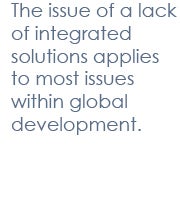
Today marks the first full day of the second annual Spotlight Health, which draws speakers and audience members from around the world to Aspen, CO, to talk about the cutting-edge health issues of our times.
Below, Aspen Institute Vice President of Policy Programs and Global Health and Development Program Executive Director Peggy Clark, and Global Health and Development Program Deputy Director Katie Drasser explain how implementing integrated approaches to issues such as poverty and health disparity can solve multiple problems at once.
New global health data by an international consortium of researchers revealed an alarming finding: while death rates continue to decline across the globe, more people are spending their days in poor health. The number of people in the world who live with health-related disabilities, such as headaches, diabetes, and hearing loss, have been on a steady climb since 1990. Three billion people in the world suffer from more than five health ailments — and 81 percent of them were younger than 65 years old.
What’s worse is that this group is not just experiencing poor health — they are also more likely to suffer economically.

Among global health experts and economists alike, it’s no news that health disparities exist between the poor and wealthy. It’s common knowledge that the poorer conditions a person lives in, the more vulnerable they are to contracting an illness, and the less adequate health care access they have. But there has also been growing awareness of the ways that health problems cause and perpetuate poverty.
Poor health results in higher expenses, contributing to less wealth for that individual and their family. And in turn, less wealth results in more vulnerability to getting sick — and the cycle continues.
This isn’t a small problem; in Kenya, 30 percent of all households faced “potentially catastrophic cost burdens” because of an illness in the family, according to a study published in Health Policy and Planning. The World Health Organization reports that more than 100 million people are driven below the poverty line each year, as a result of too much spending on health care.
So, if health and poverty are so intrinsically linked, why are we not using more integrated approaches to tackle these challenges? This issue of a lack of integrated solutions applies to most issues within global development. Current problems that exist in education, health care, environmental sustainability, and food security are deeply tied to one another; a particular issue that one area has will directly impact the other. But it’s rare that the solutions that are created consider these intersections of cause and effect.
Education challenges are addressed with education-focused solutions, not other issues that directly impact education, like malnutrition. How can students in an area with food insecurity benefit from getting an education when they’re too hungry to focus on learning?
Some leaders in the global development field are catching on and beginning to implement cross-sector approaches in their work, specifically around poverty and health. One example is a health protection program specialized for microfinance institutions created by the organization Freedom From Hunger. This program was implemented in institutions from five different countries, giving 300,000 microfinance lenders (and their families) access to health care loans, education, and products. The ultimate goal was to keep the business owners from being vulnerable to health care problems for both themselves and their families, and protect their business in the process.
Organizations like Iora Health in Seattle, Washington, and Last Mile Health in Liberia, have achieved dramatic success in their missions in large part due to their integrated and community-based approaches to health that move beyond the silos of care.
Data shows that these strategies work. In Freedom From Hunger’s program, there was a notable increase in client growth and retention in the areas where the microfinance institutions were receiving the health care services, compared to institutions that did not.
But while the data is only just beginning to reveal results, the potential of integrative approaches to health and poverty continue to be overlooked and underdeveloped. Specialization remains the norm when it comes to tackling global challenges, especially among mega international institutions that largely shape the narrative around how we tackle major global challenges of our time.
But the realization of its value as an effective intervention can be the beginning of new strides in the field of international development. We just need the commitment of others, such as representatives from different sectors, corporate partners, foundations, multi levels of government and the social service sector, to support the policy and action needed to see if it’s not the individual target, but at the nexus of many, where the solution to tackling both poverty and health lies.

